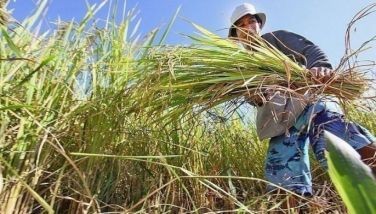Ulang, palay can live together in same field
January 21, 2007 | 12:00am
Ulang (giant freshwater prawn) can grow with rice plants in the same field.
This has been attested by studies done over the years by government aquaculturists and fishfarmers.
Actually, the rice-prawn technology is a modification of the rice-fish farming system developed by the Department of Agriculture (DA) way back in the late 1970s. The rice-fish system, however, suffered some setbacks because of inappropriate design not acceptable by farmers.
Under the modified technology, farmers allocate 10 percent of their farm for prawn culture and the 90 percent for rice production.
The water coming out of the prawn pond, which is rich in nutrients from excreta and uneaten food of the shrimps, are used by the rice plants.
"The technology offers an improved alternative source of livelihood for the farmers, since prawn is a high-value commodity that demands higher price in the market (P300-P500 per kilograms)," pointed out Department of Agriculture-Bureau of Fisheries and Aquatic Resources (BFAR) researchers Emiliana Casbedillo, Virginia Panisales, and Roselle Bucero.
The BFAR aquaculturists reported on the "Rice-Prawn Farming System" at the technology commercialization forum held recently in Lipa City (Batangas) under the auspices of the DA-Bureau of Agricultural Research (BAR).
They recalled that on-farm research on rice-prawn culture began in 2001 in the upland areas of barangay Oples and Taytay in Nagcarlan, Laguna. The sites were ideal for rice-prawn farming because of the good quality of the water as this came from springs and was pollution-free.
"Most of the rice paddies were designed as terraces and the majority of the farmers did not use pesticides or insecticide on their palay," they said.
Owing to its initial success, the project was replicated in nearby towns such as Liliw, Calauan, Bay, Sta. Cruz, and Calamba (now a city).
In 2004, fishfarmers in lowland areas in Laguna, Cavite, and Rizal also adopted the technology.
For 2006, the project further covered more areas in the CALARBARZON (Cavite, Laguna, Batangas, Rizal, Quezon) region, the BFAR researchers reported. – Rudy A. Fernandez
This has been attested by studies done over the years by government aquaculturists and fishfarmers.
Actually, the rice-prawn technology is a modification of the rice-fish farming system developed by the Department of Agriculture (DA) way back in the late 1970s. The rice-fish system, however, suffered some setbacks because of inappropriate design not acceptable by farmers.
Under the modified technology, farmers allocate 10 percent of their farm for prawn culture and the 90 percent for rice production.
The water coming out of the prawn pond, which is rich in nutrients from excreta and uneaten food of the shrimps, are used by the rice plants.
"The technology offers an improved alternative source of livelihood for the farmers, since prawn is a high-value commodity that demands higher price in the market (P300-P500 per kilograms)," pointed out Department of Agriculture-Bureau of Fisheries and Aquatic Resources (BFAR) researchers Emiliana Casbedillo, Virginia Panisales, and Roselle Bucero.
The BFAR aquaculturists reported on the "Rice-Prawn Farming System" at the technology commercialization forum held recently in Lipa City (Batangas) under the auspices of the DA-Bureau of Agricultural Research (BAR).
They recalled that on-farm research on rice-prawn culture began in 2001 in the upland areas of barangay Oples and Taytay in Nagcarlan, Laguna. The sites were ideal for rice-prawn farming because of the good quality of the water as this came from springs and was pollution-free.
"Most of the rice paddies were designed as terraces and the majority of the farmers did not use pesticides or insecticide on their palay," they said.
Owing to its initial success, the project was replicated in nearby towns such as Liliw, Calauan, Bay, Sta. Cruz, and Calamba (now a city).
In 2004, fishfarmers in lowland areas in Laguna, Cavite, and Rizal also adopted the technology.
For 2006, the project further covered more areas in the CALARBARZON (Cavite, Laguna, Batangas, Rizal, Quezon) region, the BFAR researchers reported. – Rudy A. Fernandez
BrandSpace Articles
<
>
- Latest
Latest
Latest
January 10, 2025 - 11:00am
January 10, 2025 - 11:00am
November 9, 2024 - 3:43pm
By E.H. Edejer | November 9, 2024 - 3:43pm
June 9, 2024 - 5:55pm
By Alberto Peña | June 9, 2024 - 5:55pm
May 24, 2024 - 10:00am
May 24, 2024 - 10:00am
May 14, 2024 - 3:43pm
By Ian Laqui | May 14, 2024 - 3:43pm
April 10, 2024 - 5:12pm
By Ian Laqui | April 10, 2024 - 5:12pm
Recommended





























